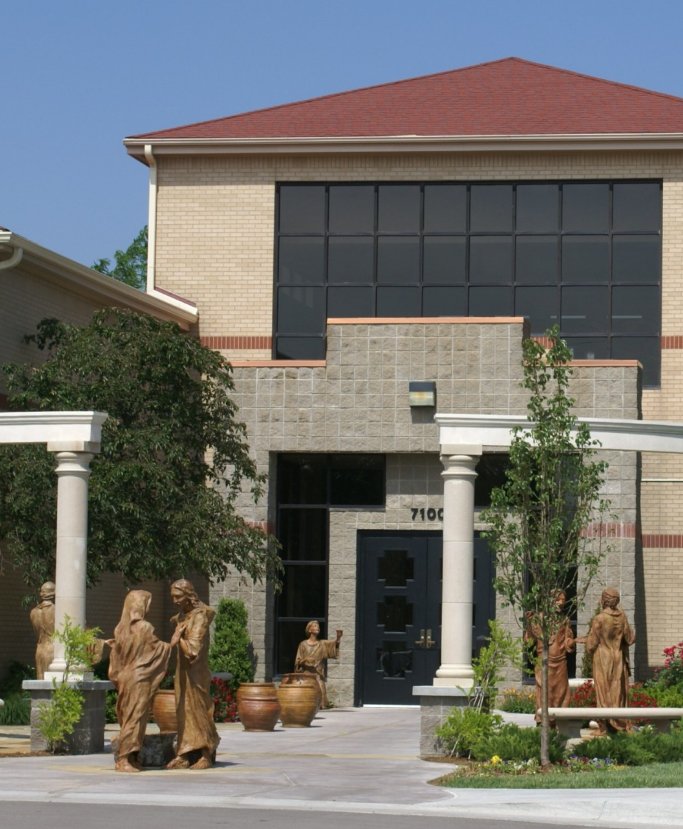the practice of staying in one Scripture text
In early July I sat one morning with my coffee, candle lit and Bible open to Jesus’ first miracle. It was a typical devotional time but then a realization struck me: My soul needed something more.
Normally I read to be informed, but that morning I sensed a need for deep replenishment and transformation of my soul.
I also sensed the Holy Spirit inviting me to stay in that text (John 2:1-12) for a while. So for the next 35 mornings I read the same story over and over again.
To stay in one Scripture text challenged me to live out Jesus’ words: "Make yourselves at home with me and my words are at home in you” (John 15:7 MSG). Staying put slowed my reading pace and sowed within me a real sense of God’s presence from the text.
Monotony was actually homey.
Emily frequently stays at the Spiritual Life Retreat center in Wichita, Kansas. I visited the center a few years ago and my first impression was its unique entry. As you walk up to the doors, you are welcomed by life-sized statues that recreate the wedding scene of Jesus first miracle.
Walking into the retreat center was like walking with the disciples into the story.
Staying at the retreat center for a few days provided us the opportunity to look at art/icons, read books, walk the grounds, and sit quietly in the chapel. We attended sessions of great teachers and talked with others about what we were learning.
Metaphorically, to stay in one text is to look around, look up words in the original language, read commentaries, meditate and gaze at the scene from different perspectives.
I’ve realized that slow and repetitive reading creates space to rest in the presence of Father, Son, and Spirit who’ve made their home in us (John 14:23). Both this passage and the John 15 passage bring the word “rest” to mind. Rest in knowing that God is real and the Spirit is speaking.
To rest in a one text is to eventually see with the eyes of your heart (Eph. 1:18).
It took my 10 days to really see (real eyes) that Jesus’ first miracle was a portrayal of his last miracle.
I remember the morning when I started reading “and on the third day.” Why is that detail there? Wait, the third day?! Is John pointing to the resurrection?
Then I read Jesus’ response to his mother’s plea for action. “It is not my hour.” When Jesus was about to enter the way of the cross he said “my hour has come” (John 16:32; 17:1).
This is a resurrection miracle, one that has provided the lift and love that my soul has longed for these past months.
When wine ran out at a first century Jewish wedding banquet, the party was over. If this happens prematurely it can be embarrassing to the host.
We all know the feeling when something runs out: time, resources, money, kindness, patience, predictability, stability or hope. But Jesus is drawn toward emptiness, toward deathliness.
Karl Barth once said that “resurrection happens only in graveyards” and I would say that fullness happens only in emptiness. Seeing and naming the emptiness as his mother did was the prerequisite to filling the ceremonial jars to the brim.
Slowly reading one text and meditating on it for days brought transformation to my inner life. Reading quickly tends to bolster the intellect which isn’t a bad thing but can cause you to miss a thing.
But a slower reading has helped me fully receive and embrace the reality of what Jesus offers: fullness of Life. It keeps my cup still for God’s out pouring.
Water to wine is a picture of apprenticeship to the One who has risen from the dead. Jesus, the living Word, who has risen me with him (Romans 6:1-2), is a reality that I need to sit with for a few extra days.
To meditate on Scripture in this way is like swirling fine wine in a glass and letting the sweet aromas release before taking a sip.
An intentional aspect of staying in a single text is believing that the Spirit would provide one idea or image to take with me that day. For example, one morning I was struck that many people didn’t know where the new wine came from… but the servants knew.
Those who did the humble work to serve others participated in the miracle. They had water splash on their hands one moment, then wine the next.
So I took that phrase with me and it gave the Holy Spirit language to encourage my heart through my ordinary day. It was a handle to carry with me.
When we left the retreat center, we walked back out through the story portrayed on the walkway. Jesus walked with us. The life-sized statues gave me a sense of the life-sized Presence that goes with us. When the disciples and the mother of Jesus left the wedding, Jesus left with them. They took their “belief” out with them (v.11-12).
The Holy Spirit walks out with us out into this world stricken by emptiness. Larry Crabb once said, “we can then follow Jesus into the lives of other people.” There is nothing fast-paced about this calling.
I believe it was St. John of the Cross who once said, “Jesus never walks by a broken, empty soul without stopping.” As we walk out into the world, united to God by the Spirit, we too can stop at empty hearts, listen, engage and request Jesus to act on their behalf.
The kind of work of Grace Discipleship is ultimately what Dr. Crabb meant. I am stepping out in belief that Jesus is still transforming water to wine, pain to joy, and hardness of heart to tenderness. We all have the wedding invitation to humbly join in the miracle of transformation.
The servants knew!
So may we take our time in one text. May we restfully read it again and again swirling the wine in the glass. May we notice the resurrection life proceeding from death, and drink in the joyous presence of Father, Son and Spirit.
Amen and Cheers!
John P. Freeman

